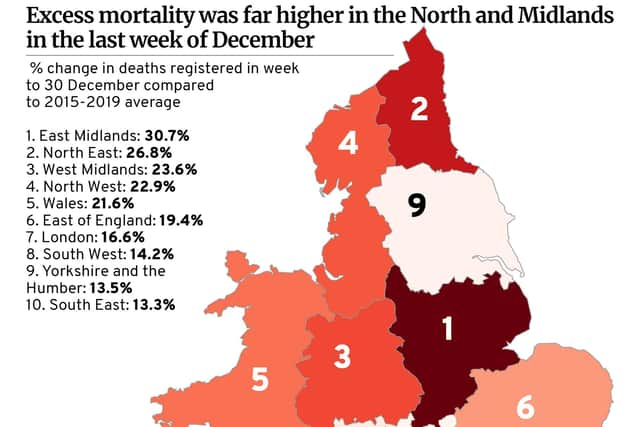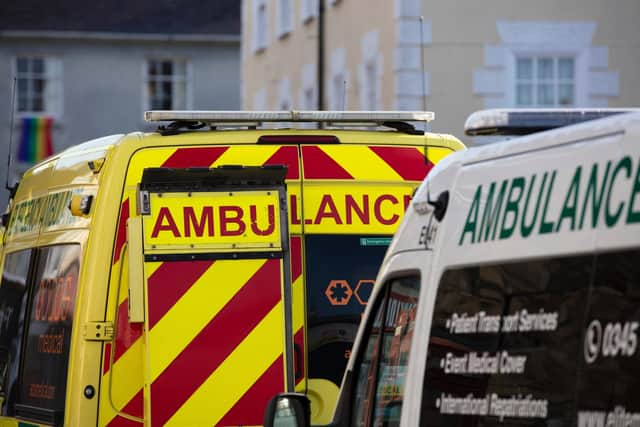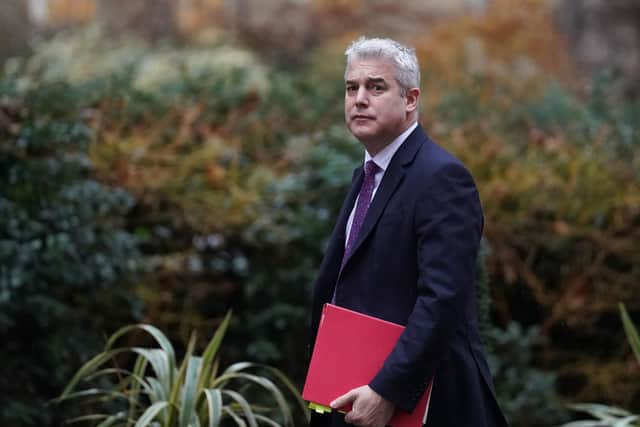Excess deaths 2022: How many extra people are dying this winter - and why the North is being hit hard
and live on Freeview channel 276
Office for National Statistics (ONS) figures have been released showing an area-by-area breakdown of how many excess deaths have occured in the past eight weeks, and how – in nearly every area in Lancashire – they are worse than pre-Covid days.
What are the figures?
ONS data for weeks 45 to 52 of 2022 show:


- Preston’s had 236 extra deaths compared to a pre-Covid average of 187 (26.2 per cent increase)
- South Ribble had 176 extra deaths (up 3.7 per cent)
- Chorley had 215 extra deaths (up 19.3 per cent)
- Ribble Valley had 91 extra deaths (down 9 per cent)


- Fylde had 193 extra deaths (up 20.8 per cent)
- Lancaster had 289 extra deaths (up 18.5 per cent)
- Blackpool had 335 extra deaths (up 13.3 per cent)
- Wyre had 283 extra deaths (up 16.5 per cent)


North-south divide
Advertisement
Hide AdAdvertisement
Hide AdAnalysis shows significantly more excess deaths are currently being recorded in the North of England and Midlands compared to the South, with pressure on the NHS “likely” to be a factor, The Post can reveal.
CLICK here for why North West paramedics voted to go on strike


In the four weeks to December 30, deaths in the North were up by 20.6 per cent compared to the pre-pandemic average, while in the South they were up by 14.7 per cent.
The disparity was also evident over the last eight weeks, covering back to the week ending November 11, with deaths in the North up by 16.7 per cent compared to 12.1 per cent in the South and 15.3 per cent in the Midlands.
The difference is the equivalent of an extra 1,107 northerners dying over the last eight weeks, compared to the number that would have died if excess mortality was at the level seen in the south.
“Stark light”
Advertisement
Hide AdAdvertisement
Hide AdLabour shadow levelling up secretary Lisa Nandy described the disparity as “unconscionable”, while a health expert from the Institute for Public Policy Research (IPPR) said the analysis put the reality of health inequality – and the extra burden it puts on the health system in northern regions – into a “stark light”.
While the official measure of excess mortality used by the ONS in its national statistics compares deaths in 2022 to the average in 2016, 2017, 2018, 2019 and 2021, NationalWorld – the parent company of the Post – has chosen to use the pre-pandemic average (2015 to 2019) to avoid any distortion caused by the disproportionate impact of Covid deaths in northern regions. The ONS does not publish its own comparisons at a regional level, and said it could not comment on the trend NationalWorld uncovered.
NHS crisis
Concerns have been mounting about the potentially deadly consequences of the crisis gripping the NHS this winter, which doctors have described as the worst they have ever experienced.
Hospitals in England have been dangerously busy over the Christmas period, hundreds of thousands of callers have abandoned their attempts to contact NHS 111 and tens of thousands of patients have faced delays at A&E after being taken to hospital by ambulance.
Advertisement
Hide AdAdvertisement
Hide AdMany health experts also theorise that long waiting lists for elective care, or people having put off coming forward over conditions such as heart problems during the pandemic, are also playing into the rise in deaths in 2022.
Chris Thomas, principal health fellow and head of the commission on health and prosperity at IPPR, said existing regional health inequalities – and the greater strain on services that poorer health can cause – means that northern health systems can feel the strain particularly acutely at times of unprecedented demand.
He said: “We saw that during the Covid-19 pandemic where the places that were most likely to experience high levels of infection or high levels of mortality or where the system was particularly under strain in terms of healthcare tended to be places where health inequalities were higher, which was often places like the North East, the North West, Yorkshire and the Humber.
“What we’ve probably seen is a bit of a reiteration of that trend in the last few weeks while we had that really big infection of the flu and Covid-19 twindemic playing out, so I think it’s fairly likely that the kind of pressures that we’ve seen in the NHS over the last few weeks through the winter are playing into this [excess deaths].”
Life expectancy
Advertisement
Hide AdAdvertisement
Hide AdPeople in northern regions have shorter life expectancies and live fewer years before developing disabilities or health problems compared to southern regions, according to figures from the Office for Health Improvement and Disparities.
Commenting on the higher number of excess deaths in the North, Mr Thomas said: “The sad part of it is that it tracks very strongly with what we knew about health inequalities before as well. We tend to see that for almost every health indicator, whether it’s cancer, cardiovascular disease, respiratory disease, that things like excess mortality, preventable mortality, they tend to track to region, there tends to be a very strong north-south divide.”
“Be cautious"
The Department for Health and Social Care was approached for comment. It pointed only to comments made by Health Secretary Steve Barclay in the House of Commons earlier this week who said he had discussed the issue of excess deaths in detail with the chief medical officer and the medical director for NHS England.
He said: “The point to note is this is something firstly that has happened internationally. It can’t be ascribed just to one issue as is so often the case.
Advertisement
Hide AdAdvertisement
Hide Ad“Some of the excess mortality will be due directly to Covid itself, albeit that will be a diminishing proportion, but it is also the case that some of the non-Covid excess mortality will be driven by quite a wide combination of factors. I think we have got to be quite cautious when those sort of numbers are bandied around.”
